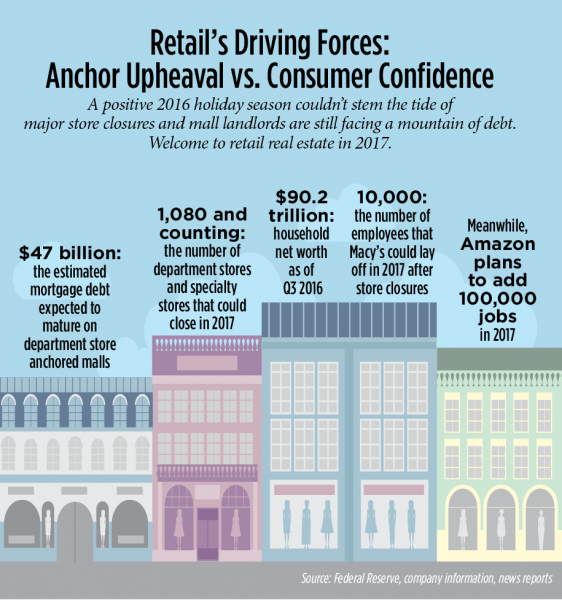This holiday shopping season seemed to be a decent one for the retail sector, with the Thomson Reuters Same-Store Sales Index posting a 2.4 percent increase for December, above expectations.
Healthy same-store sales growth notwithstanding, there is a storm passing over the retail sector. Going into the New Year, Macy’s, Sears, Kmart and Kohl’s among department stores, all announced disappointing results, adding that store closings would follow. Specialty stores including The Limited, Wet Seal and American Apparel also turned in poor sales numbers. Closings among those retailers alone number well past 1,000 as companies face the inevitable: consumers’ shopping habits had changed and they simply cannot count on business longevity with large fleets of brick-and-mortar stores.
Poor sales and shuttered locations is a familiar story that helped define much of 2016 for many retail chains. Tempered expectations should follow the retail sector into the New Year. In an update to its World Economic Outlook, the IMF forecasted that the U.S. could attain economic growth of 2.3 percent and 2.5 percent for 2017 and 2018, respectively, as a result of the policies of president-elect Donald Trump. It would be an improvement over the 1.6 percent that the U.S. achieved in 2016. How much of that growth, however, will positively impact the U.S. retail sector?
If companies were looking forward to a more positive story with the turning of the calendar, they might have to wait a bit longer. We took a look at five trends that will drive the retail property sector in 2016, and found that issues related to sluggish sales and store closings will continue to challenge retailers.
- Mall tenants will continue to renegotiate their leases, or exit malls altogether, if department store anchors continue to close stores. Specialty retailers pay the bulk of rents that support malls, and many have clauses in their leases specifying that the landlord must maintain a certain number of anchors, says Howard Davidowitz, chairman of Davidowitz & Associates, Inc., a national retail consulting and investment banking firm headquartered in New York. The closure of so many anchor locations by so many operators presents a very complex challenge for landlords. “You don’t have a mall without anchors,” Davidowitz says. “Department stores advertise like crazy and drive traffic.” Despite a long list of successful store operators that draw big crowds and post healthy sales results, including T.J.Maxx and Costco, in-line retailers are unlikely to shift their thinking and embrace those kinds of stores as anchors.
- While department store operators figure out a strategy for long-term survival, mall landlords will have to come up with a way to offer experiences to shoppers that Amazon.com cannot put in a box and ship. Samsung, for instance, set up an experience store in New York City’s still-trending Meatpacking district, says James Chung, an executive managing director at real estate services firm Cushman & Wakefield and the retail practice group leader for the company’s West region.
- Class –A malls will continue to thrive. For the past five years, top-tier malls have maintained or increased their rents per square foot, and Chung expects them to continue outperforming class-B and class-C malls in 2017.
- With a total net worth of about $92 trillion, American households are feeling wealthier and more confident. Chung expects this to translate to continued increases in consumer spending in 2017. “For such a long time there was a lot of fear about e-commerce,” Chung notes. “At this point we are at the beginning stages of understanding how the two can work together.” Retailers are increasing their understanding of how to engage with consumers both in-store and online.
- Hopefully, retailers can figure out how to engage with customers in ways that can boost sales and keep them inside malls. The retail real estate sector is facing an enormous challenge over the next 18 months—the maturing of about $47 billion in debt, notes Davidowitz. “I personally think the lenders are going to be very tough,” he says. “They will enforce more rigid terms about renewing loans, they might raise rates and make covenants stricter.”
If anything is sure about the retail industry it is that consumer tastes, technology and business conditions change. As mall landlords settle into a new year, which promises to bring major changes, these trends will likely shape much of their short-term strategies for prosperity.


